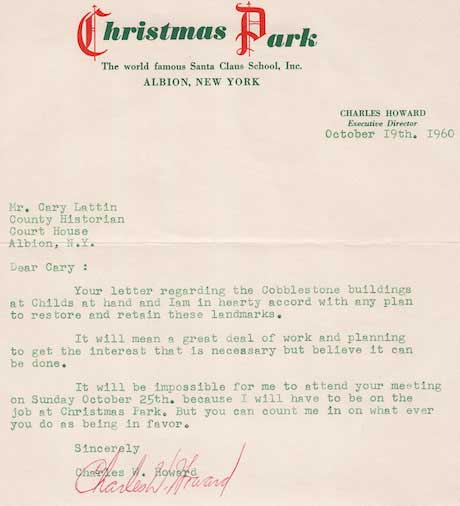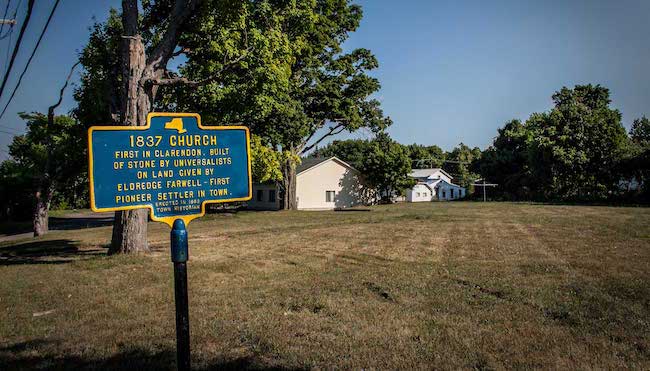Historian shares his Christmas wish: historic preservation
“Overlooked Orleans” – Vol. 4, No. 50
The Christmas season is upon us and it is customary to write a piece about Charlie Howard, his Santa Claus School, or Christmas Park. If I had the privilege of sitting on Howard’s lap, what would I ask for? Simple answer: historic preservation.
Unfortunately, our history is marred by poor decisions even though we make some of those decisions with the best intentions. The protection of our historic treasurers is perhaps the best representation of this. Material culture serves a valuable purpose in the process of interpreting the past. Void of any physical representation of past cultures, we would lose all ability to understand the lives of those who lived without a voice.
Historic preservation is one of the four basic functions of the municipal historian; preservation of documents, records, diaries, ephemera, and photographs, but also the preservation of structures deemed important to the history of our communities. Past historians have carried the burden of this cross for decades, some experiencing success and others failure.
Take for instance the once beautiful limestone Universalist Church in Clarendon. A focal point in the community for over 150 years, its life cut short after a painful battle against the ages. In 1967, the family of Earle Smith attempted to prevent the destruction of the building by petitioning the New York State Convention of Universalists to deed the property over to a newly formed private corporation. At some point, the Clarendon assessor realized the property was taxable and placed it back on the rolls.
The result of such undue burden forced the corporation to offer the property to the Orleans County Historical Association and Town of Clarendon with both entities refusing. The property was sold at auction on August 21, 1980, slowly creeping into an irreversible state of disrepair. Community officials met in 2005 to discuss the future of the structure. Some residents felt that taxpayer dollars should not support such a project and one taxpayer remarked, “a farmer never feeds a dead horse, and this building is a dead horse.” The property was sold May 6, 2006 and demolished soon after leading one historian to write, “the people of Orleans County absolutely had an architectural jewel in the historic Clarendon Universalist Church…and no one was smart enough to preserve it, what a shame!”
A rather shabby house stood near the intersection of Platt and East State streets in the Village of Albion, adjacent to the Free Methodist Church. Once the home of Dr. Orson Nichoson, a pioneer physician and the first county clerk, the brick home and attached framed wings constituted one of Albion’s earliest homes. County Historian Bill Lattin estimated the house was constructed prior to 1835 and possibly as early as the 1820s, perhaps several years before the incorporation of the village. That home was later razed to make way for a parking lot.

Charles Howard sent a letter of support in favor of the newly formed Cobblestone Society in 1960.
Another other example included the sudden disappearance of the old Buffalo, Lockport, & Rochester Railway power station, a large cast cement block structure that sat on the far east end of East State Street near Butts Road. Yet another, perhaps without any inherent value on the surface, was a once stately home that sat at 106 South Clinton Street. The property was a frequent meeting place for local suffragists who labored to organize suffrage schools and local conventions.
Architecture Destroyed in Orleans County, a wonderfully thorough account of historic structures that vanished over the lengthy history of our area, calls attention to dozens of valuable assets lost. Of course, the short volume is in need of an update as the above-mentioned examples have occurred during my lifetime, after the book’s publication. Although the examples of material culture lost to progress over the last decades are numerous, there are plenty of examples that demonstrate the rewards that come with persistence and hard work.
Home Leasing LLC’s recent undertaking of renovation work at the former Holley High School, the Town of Clarendon’s purchase of the Old Stone Store as a records storage site and office for the historian, and the Orleans County Historical Association’s ongoing work on the Gaines District No. 2 Cobblestone Schoolhouse all represent huge wins for the preservation community. Such efforts are supported by thousands of volunteer hours and community leaders who lobby for funding.
A letter written by Charlie Howard to Cary Lattin on October 19, 1960, regarding early efforts to establish the Cobblestone Society says a great deal about Howard’s community-centered mindset. He wrote, in part, “Your letter regarding the Cobblestone buildings at Childs at hand and I am in hearty accord with any plan to restore and retain these landmarks. It will mean a great deal of work and planning to get the interest that is necessary but believe it can be done…You can count me in on what ever you do as being in favor.”
I can rest assured that if I had asked Santa for historic preservation, he would have delivered!






































































